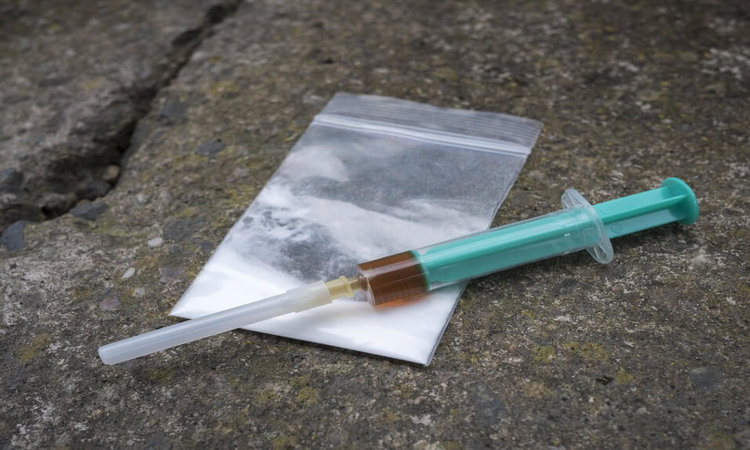
Carfentanil is a synthetic opioid similar to heroin but it is, incredibly, 5,000 times more potent. It is an analog of fentanyl, a powerful painkiller that is used to treat severe pain and also in hospital settings for general anesthesia. Unlike fentanyl, however, carfentanil is not indicated for use in humans – commercially, it is used to sedate large animals such as elephants.
Carfentanil was developed in the early 1970s by chemists at Janssen Pharmaceuticals and is now classified as a Schedule II substance by the Drug Enforcement Agency.
Carfentanil is so incredibly powerful that people handling it are required to wear protective clothing in order to avoid incidental skin contact – indeed, just a tiny amount can be lethal.
And yet, carfentanil has been responsible for hundreds of deaths in the United States in recent years, due to dealers lacing it into heroin and other substances. While a few people build a tolerance to fentanyl high enough to sustain the abuse of carfentanil, most don’t realize this incredibly potent substance has been combined with their drug of choice.
Side Effects of Carfentanil Use
Due to its potency, the most common and serious effect of carfentanil use is death. For those who consume carfentanil and do not die, effects are similar to those as heroin or fentanyl.
Besides a brief euphoric high and sedation, effects may include the following:
- Runny nose
- Dry mouth
- Slurred speech
- Restlessness
- Insomnia or sleep disturbances
- Excessive sweating
- Anxiety
- Muscle aches
- Nausea
- Constipation
- Abdominal cramps
- Depression
- Inability to concentrate
- Impaired memory
- Loss of consciousness/responsiveness
- Depressed respiration
Street Names for Carfentanil
- Apache
- China White
- China Girl
- Drop Dead
- Gray Death
- Serial Killer
- Tango and Cash
- TNT
Carfentanil Addiction
Carfentanil, like all opioids, has a high potential for addiction when abused. Addiction is characterized by two conditions that develop over time – tolerance and dependence.
Tolerance occurs because, with regular use, the brain stops responding as intensely at it once did – simply put, repeated exposure = reduced response. As a result of this diminished response, users are forced to consume more and more of their drug of choice in order to achieve the same effect.
For this reason, people who develop a high tolerance are also at a much higher risk of overdose and death.
Dependence occurs due to a drug’s effect on the brain’s reward center. When the becomes brain accustomed to the presence of the drug, it can no longer function normally, and unpleasant withdrawal symptoms manifest upon cessation. These withdrawal symptoms are not usually fatal, but in extreme cases, they can be.
Addiction also results in many adverse behaviors that reflect its true nature. These include, but are not limited to the following:
- Compulsive drug-seeking behavior such as stealing or borrowing money
- Neglect of important responsibilities associated with work, school, family, etc.
- Engaging in criminal activity and encountering legal issues related to drugs or alcohol such as driving while intoxicated
- Financial difficulties
- Family conflict and interpersonal/social problems
Overdose
A carfentanil overdose can only be treated with Narcan (naloxone), an opioid antagonist that reverses the drug’s effect and halts central nervous system depression.
Signs of an overdose include the following:
- Loss of consciousness
- Unresponsiveness
- Awake, but unable to talk
- Breathing is slow and shallow, erratic, or stopped
- Cyanosis (blue or purple skin)
- Choking sounds, or a snore-like gurgling noise (sometimes called the “death rattle”)
- Vomiting
- Limpness
- Pale skin
- Pulse (heartbeat) is slow, erratic, or undetectable
If you or someone you know is experiencing these symptoms, please call emergency medical services immediately.
Treatment for Carfentanil Addiction
Treatment for carfentanil abuse begins with a medically-managed detox. During this process, which could last several days, the patient is monitored around-the-clock to ensure safety. Medications are often administered to treat withdrawal symptoms and reduce drug cravings.
After detox, patients are encouraged to participate in a comprehensive treatment program for 30 days or longer. During this time, patients receive corrective interventions such as counseling and behavioral therapy. Treatment also includes 12-step meetings and alternative practices such as yoga and meditation.
Patients often begin with partial hospitalization treatment at our center. Many then move on to intensive outpatient treatment and live in a private residence or sober living home and visit the center several times per week to continue with recovery.
After discharge, aftercare planners help the patient find other resources such as counselors or psychiatrists, and alumni activities offer long-term group support.
Support, encouragement, and motivation are critical tools in the battle against addiction. Through therapy, counseling, and peer support, you CAN regain your sanity and enjoy the happy, fulfilling life you deserve.
If you or your loved one is suffering from substance abuse, please seek help as soon as possible. You can beat addiction and reclaim your life! Please contact us for a free consultation.